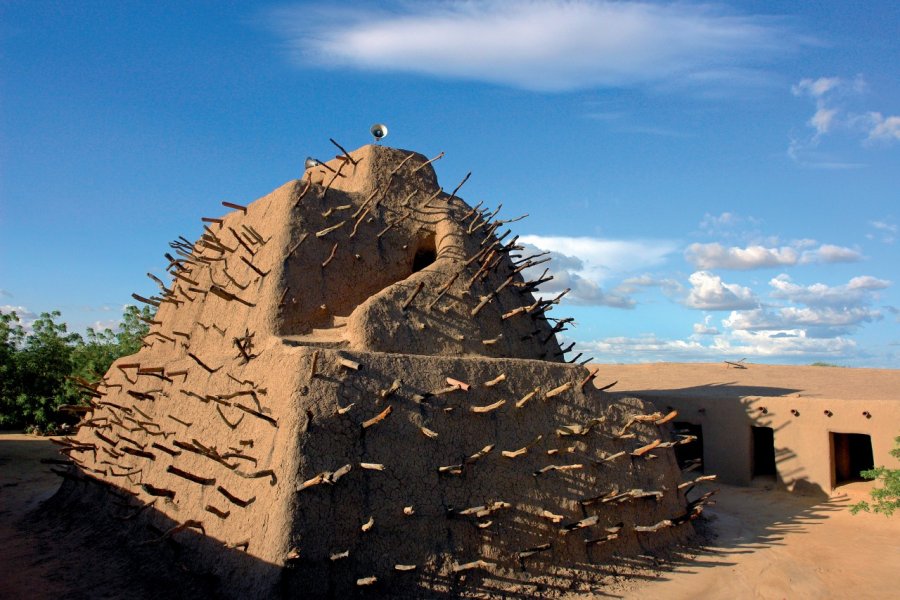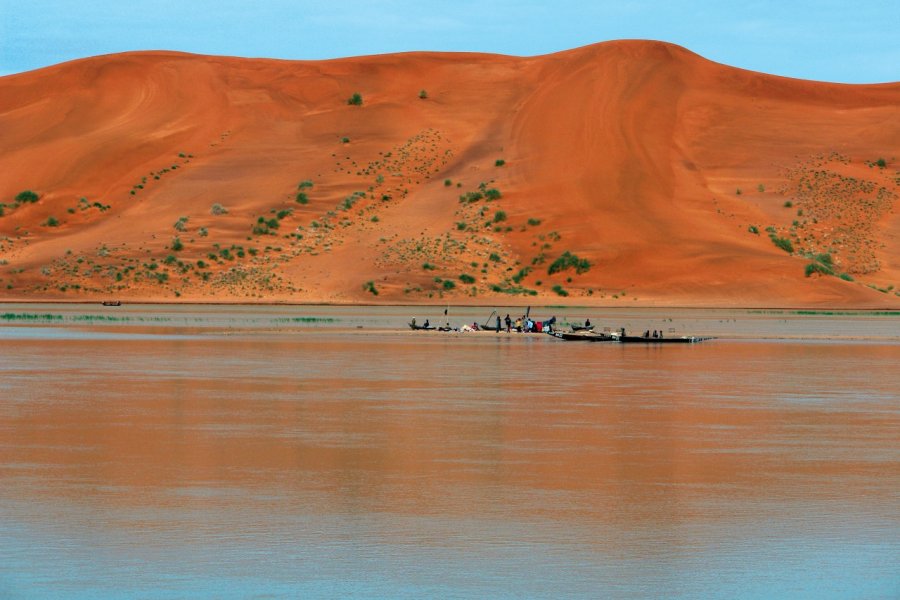Travel Guide Gao
Find an accommodation
Advertising
Gao is nicknamed "the city of Askia" in tribute to the dynasty that led the Empire to its apogee. Indeed, Gao was the capital of the largest and last African empire.In spite of past splendor, Gao is now a city that dies. With the breakthrough of the desert, Gao now mainly evokes drought problems. However, with the proximity of the Algerian border, the city succeeded in becoming a trade exchange centre between Europe and West Africa. In fact, she was mostly famous for the traffic in cars that were there. The Algerian civil war has dried up this resource, accentuating the decline of the city. Yet Gao can rely on the expansion of tourism to develop the region.The Songhai capital is the last port of the Niger River before the border with Niger. At the desert gate, Gao can become a pleasant base camp for organising Saharan expeditions in the Adrar des Ifogha or Vers.The city was not built with great aesthetic care. But Gao has better preserved his historic legacy than other African cities. The city is home to the 2004 th century funeral stelas and the tomb of Askia emperors, which have been classified as UNESCO World Heritage since. Gao, with its terraces, looks like an Arab city. Two fascinating peoples, the Tuareg and the Songhai live in Gao. The Songhai are recognized for their hospitality, their sense of celebration and their gastronomy. We like to remember here that the Songhai know very well cooking. A bridge was built on the River Niger and it is a considerable unifying link for Northern Mali and for peace of the Adrar des Ifoghas.Visitors can taste local specialities such as toukassou, alabadia, sourountou and especially fakouhoye. Gao collects Moorish art productions from the whole region, which delight tourists. The prices of the objects that can be purchased are significantly lower than those of Timbuktu.A little history… The small Songhai kingdom was born in the th century, not far from Gao, to the east. Its founders are the legendary Za or Dia-Yamin, from Yemen. In 690, a fisherman, the Sorko, founded Gao after being chased by the slide, the first songhai kings. At that time, Gao is a city of second importance. The Songhai capital is Koukia, an island of Niger (between the present Ansongo and the Niger).In 1009, during the conversion to Islam of Dia Kossoï, the fifteenth king of the slide dynasty, we witnessed the movement of the court and the capital to Gao, a meeting place for the caravans of Muslim Berber merchants coming from the Maghreb, Spain and the Near East. Influenced by the Berbers and placed under the hegemony of the slide, Gao's population quickly islamise, making Gao one of the first outbreaks of black Islam.The history of the Songhai Empire is sometimes confused with those of the Empires-Ghana empires (up to 1200) and Mali (from 1270) that, it.Located on the banks of the Niger, at the gates of the Sahara, it was the meeting point between the Mali empire and the Tuareg. Far from Summoned, Gao, the capital of the Songhai kingdom, was conquered by the Mali Empire only in 1325, under the reign of Kankou Moussa. He captured two princes of Gao. Ali Kolen and Selman Nar, both sons of Dia Assiboy, return to the city which falls under the yoke of the Sonni.Constantly rebel with its overlord, the Empire of Mali, the Songhai Empire finally eclipse it in the th century to become the greatest power in West Africa. Of the sixteen Sonni who have reigned, the most important is undoubtedly Sonni Ali Ber, "If Ali", the Cavalier, always winner, never defeated. He rose to the throne in 1465 and began extending his father's domain. However, some unrest will facilitate the movement of the activity of the cross-Saharan trade towards Timbuktu, while, as part of its policy of conquest, it takes control of Timbuktu in 1468 and definitively frees the Empire songhai from the guardianship of its neighbour, the Empire of Mali.The Songhai Empire then benefits from the fact that the main gold fields are no longer Bambouk or Bure (within the Mali Empire), but Akan mines, whose production naturally joins Timbuktu and Gao to exchange the salt of desert mines and other commodities. The two main cities of Du then become the high places of the trans-Saharan trade. Sonni Ali mysteriously disappeared in 1492 in the waters of Koni. Sworn enemy of the Tuareg, the Fulani and the Mossi, which he holds for looters, Des to whom he blames their spiritual allegiance to the king of Morocco, he will have extended his empire from Segou to Walata, Mauritania, and Gao to Kanta-Kebbi, Niger.In 1493, the Askia dynasty was born following the overthrow of Sonni Bakary by army General Mohamed Sylla, nephew of Sonni Ali. He was named Askia Mohamed Touré.A great organizer, he successfully administers his empire, which extends the limits. The capital, Gao, has more than 70 000 inhabitants. It is under the Askia that the empire is experiencing its greatest expansion. Mohamed Askia, unlike Sonni Ali Ber, is a true Muslim. In 1496 he went on pilgrimage to Mecca. A protector of intellectuals, it is under his rule that Timbuktu becomes an important spiritual centre, with universities and Koranic schools, where the scientists of the Muslim world are tributary. He is also a great administrator, a great builder and built the town of Tindirma, as well as several major Songhai buildings, including the famous Askia pyramid tomb. Until the end of the th century, Gao surpassed Djenné and Timbuktu as a cultural and commercial centre on the southern shore of the Sahara. This fact is easily explained by the ideal position, occupied by Gao at the time.Mohamed Askia was overthrown by his son, Askia Daoûd (1549-1582). The Songhai Empire reached its climax under its reign. In his death, internal conflicts reduce the power of the state. The powerful Songhai army, of thirty thousand riders and soldiers, was defeated in 1591 by a few thousand Spanish mercenaries on the balance of pacha Djouder of Morocco, who have firearms. The Moroccan Armas will prefer Timbuktu to Gao, capital of the largest empire in Africa, extending from the Atlantic to the Sahara and Guinea in Niger. None of the states that will emerge following the Songhai Empire will succeed in completely dominating the region. While some will succeed in extending beyond their natural borders, their power will remain lower than that of the previous great empires. However, the most important of these will be the Toucouleur Empire of El Hadj Omar Tall which, during the second half of the th century, will be forced into the context of the advancement of French troops, as the most powerful in West Africa.
Weather at the moment
Advertising
Organize your trip with our partners Gao
Transportation
Book your plane tickets
Car Rental
Boat rental
Accommodation & stays
Find a hotel
Holiday rental
Find your campsite
Tailor-made trip
Immersion travel
Services / On site
Activities & visits
Find a doctor
Find unique Stay Offers with our Partners
Pictures and images Gao
Other destinations nearby Gao
100 km away





